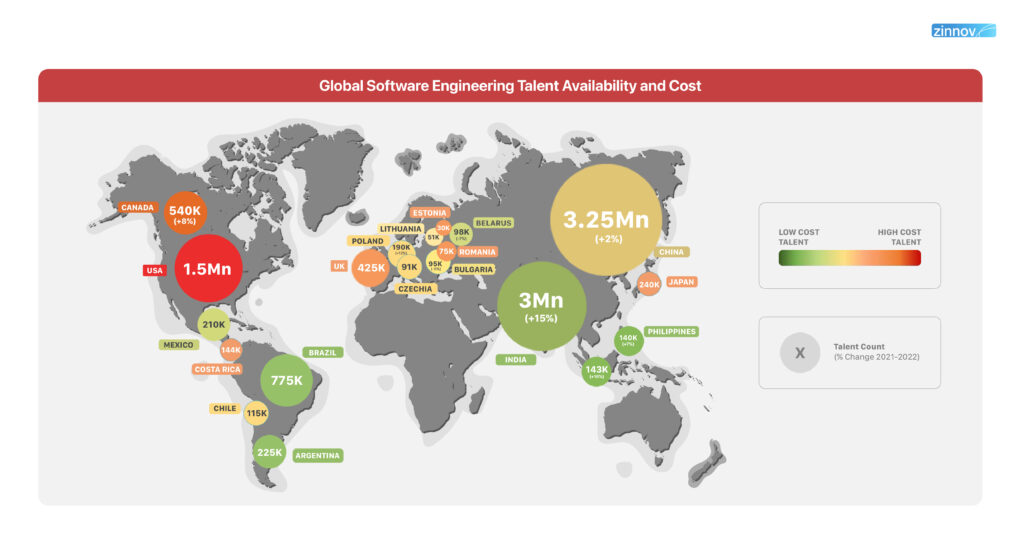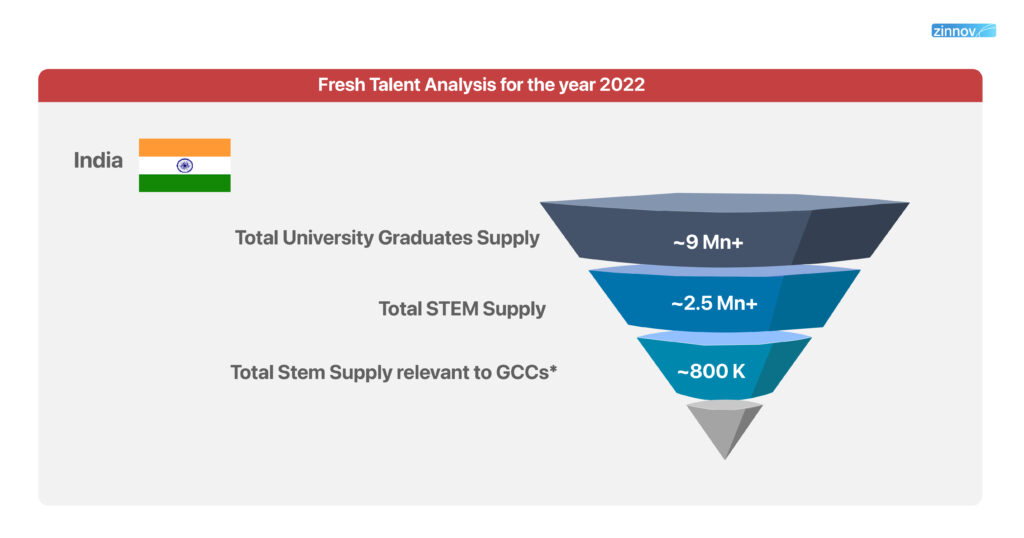|
|
Captive Centers are offshore units established by multinational corporations to perform a range of strategic functions. These centers leverage specialized talent, cost arbitrage, and operational efficiencies in various locations worldwide. By setting up Global capability centers, companies can maintain control over their operations, ensure quality, and align their offshore activities with their overall business objectives.
Yet leaders must also weigh the risks and complexities while planning the expansion globally. Without a good plan, expansion can lead to messy and disjointed systems and poor results.
Many forward-thinking companies including tech giants like Texas Instruments, IBM, Microsoft, and Google, recognize that to fuel rapid growth and stay competitive, they need to optimize costs, access global talent, and drive innovation. Some have established joint ventures, while others have turned to outsourcing or establishing operations in other countries. Yet, each of these approaches comes with its own set of challenges, underscoring the complexity of global expansion.
Joint ventures can lead to conflicts in priorities and cultural differences, making it hard to stay focused and make decisions. Outsourcing might lead to losing control over important processes and could endanger the security of intellectual property. Additionally, running operations in different locations brings challenges in maintaining consistent management, handling data properly, and using insights throughout the company. These issues underline the importance of a unified and strategic plan for expanding globally.
Is an Offshore Development Center Your Key to Global Success?
This is where Global Capability Centers (GCCs)/Captive Centers, emerge as a compelling solution, offering a way to consolidate operations, safeguard intellectual property, and maintain control over offshore activities. Unlike outsourcing, a GCC is fully owned by the parent company, ensuring that strategic objectives remain aligned and cultural integration is managed more effectively.
This model not only mitigates the risks associated with dispersed models but also capitalizes on the benefits of global expansion.
A US-based Digital Customer Engagement company, serving over 12,000 global brands and retailers, recognized the need to expand its capabilities through a Global Capability Center to leverage the global talent pool for product development while optimizing R&D talent costs. They partnered with Zinnov, who helped shortlist locations, provided end-to-end support, and delivered transformative results, including adding 80 new employees, achieving annual savings of USD 12 Mn in talent costs, and successfully developing multiple products from the new center, all within three months, showcasing the power of strategic collaboration in driving innovation and accessing global talent.
But what makes setting up a GCC an advantageous strategy for organizations looking leverage the global opportunity?
A key advantage of a GCC is the major cost savings achieved by strategically allocating resources worldwide. By placing centers in strategic talent hubs abroad, companies can significantly reduce labor costs without sacrificing quality.
GCCs provide access to a wide and diverse talent pool that organizations cannot reach by operating in just one location. For instance, by setting up GCCs in India, leading companies can tap into the country’s growing professional workforce and elite graduates from top engineering schools like the IITs.

The sheer scale and quality of specialized resources in software development, quantitative analytics, and digital business concentrated in Indian talent hubs allows GCCs to achieve capabilities impossible within domestic limits alone. Financial giant Goldman Sachs has invested heavily in large India GCCs to enhance a wide range of functions, from algorithmic trading systems to predictive client data tools, surpassing the capabilities currently available through Wall Street resources.
The introduction of cultural diversity, regional insights, and fresh perspectives in Indian GCCs fosters an innovation ecosystem that is often missing in US-centric teams. This environment allows solutions to be developed with a deep understanding of the unique needs and technological limitations of developing markets, leading to disruptive products that are then exported globally. For example, Lowe’s Bangalore GCC is at the forefront of innovating with VR and AR to create enhanced customer design experiences, taking advantage of India’s leadership in immersive technologies.

So, whether aiming for cost-effective scaling of specialized operational skills or seeking a boost in innovation through diversity, India’s talent pool presents transformative opportunities for GCCs.
GCCs offer significant advantages by consolidating operations that were once scattered into a single, unified hub. This approach removes the inefficiencies and duplications common in fragmented operations.
GCCs ensure quality control across different locations by standardizing systems and streamlining processes. They gather expert talent into Centers of Excellence, avoiding the fragmentation and duplication of efforts. Corporate goals are effectively translated into coordinated initiatives across all markets with the whole capability center operating smoothly as a global extension of the headquarters.
The ability to quickly scale operations and adjust strategies is crucial for competitiveness in today’s rapidly evolving global business landscape. Leading companies have found that GCCs provide a versatile structure that allows them to respond to changing market demands and seize growth opportunities around the world swiftly.
A Global Healthcare organization recently set up a GCC in India. Initially dependent on an outsourcing partner, the Healthcare giant faced uncertainty when the partner was acquired, risking a shift to more generic services. With Zinnov’s help, the company moved to an in-house model, enhancing innovation and personalization. This shift not only maintained operations but also opened growth avenues, showing GCCs’ importance for flexibility and scalability in the global market.
As businesses navigate the strategic crossroads of globalization, Global Capability Centers (GCCs) emerge as not just an option but a critical component of a successful global strategy.
Next time your leaders discuss entering global markets, think about using a Global Capability Center (GCC). A well-managed global capability center provides benefits like unified processes, more innovation, and better control, helping with faster worldwide growth beyond regional limits. For companies mainly operating domestically, considering a global excellence center could be the quickest way to speed up expansion.
A Global Capability Center (GCC), commonly referred to as a /Captive center/Global in-house Center (GIC), is an offshore or nearshore entity fully owned and operated by a parent company. These centres provide a wide array of specialized services, ranging from information technology (IT) and research and development (R&D) to complex back-office functions. GCCs play a pivotal role in driving innovation, enhancing cost-efficiency, and accessing diverse talent pools.
India is the leading destination for Global Capability Centers (GCCs), offering a highly skilled tech-talent, cost advantages, and a mature technology ecosystem. Numerous Fortune 500 companies have established their GCCs in India to foster innovation and accelerate digital transformation.
GCCs in India provide a 40-60% reduction in operational costs while enhancing productivity and minimizing reliance on outsourcing. With access to diverse talent, these centers enable a wide range of work processes, driving efficiency, innovation, and a positive impact on both top and bottom line.
While GCCs benefit all industries, they have the most significant impact on sectors such as software and internet, healthcare, retail, BFSI, manufacturing, and semiconductors. These industries leverage GCCs to drive innovation, efficiency, and strategic growth.
GCCs accelerate AI and automation initiatives, including cloud computing and cybersecurity, enabling companies to adopt new technologies more quickly. This enhances business agility, capability, drives product innovation, and elevates the customer experience.
GCCs provide full ownership, ensuring complete control over operations, data security, and strategic alignment with corporate goals, while also delivering long-term cost benefits and innovation advantages.
India is the GCC capital of the world, driven by its large and diverse tech talent pool, cost arbitrage, strong global leadership, mature GCC ecosystem, thriving startup landscape, and pro-GCC government policies. Other key locations, such as Poland and the Philippines are emerging GCC locations.
Most companies establish a fully operational GCC in India within 90 days to 6 months, with the timeline depending on factors such as the business case, financial modelling, change management, infrastructure, and compliance requirements. GCCs powered by Zinnov are designed to accelerate this process, as we provide a one stop solution from center setup from Design, Build, Operate and Scale.
Zinnov has helped Fortune 5000 companies, enterprise companies, SMEs build high-performing GCCs. With over 23 years of experience and 190+ GCCs set up and transformed, Zinnov offers end-to-end GCC-as-a-service through our DBOT framework. We provide comprehensive support from design and build to operate and transform, including business case planning, financial modelling, location analysis, talent acquisition, employee branding, compliance, innovation programs, operational excellence to name a few ensuring success and business continuity.